How a Jeep Wagoneer Broke FIA Rallying, and Caused the 4WD Ban

In the 1972 round of the FIA manufacturer's rally championship, every country had its hero. At that year's Rallye Monte Carlo, Sandro Munari's Lancia Fulvia 1.6 HF held off the Porsches and the Datsuns in a home victory for Italy. In Sweden, Stig Blomqvist notched up another win for Saab, burnishing a legend where decades later “Stig” would simply mean “racing driver.” Mk 1 Escorts took first and third in the East Africa Safari Rally, the former driven by a Flying Finn, the latter driver Kenyan-born. Quick-witted, compact drivers in little sports cars were everywhere, setting a blistering pace from Austria to the Acropolis.
But, in 1972, the FIA also came to America, and here, a Leviathan emerged.
Between the trees, a flash of white. Hear it before you see it, not a cammed-up Lancia with its odd V-4 rasp, but a bellowing 5.9-liter V-8, sucking down fuel through a Holley carb and belching thunder through dual exhausts. A huge great whale of a thing, flanks spattered with the winter mud of the Michigan peninsula. A stab of the brake and the driver throws the great beast sideways, all four wheels skittering in the gravel. The most unlikely of rally machines, a Jeep Wagoneer, its sides painted with the name “Moby Dick 1.”

Walter Röhrl, spare and lean, began as an alpine ski racer. Sébastien Loeb, short and muscular, got his start as a champion gymnast. Gene Henderson, driver of the Wagoneer, was a bear.
A former Navy signalman, he'd served in the Pacific in World War II, among the first on the beaches to direct artillery fire from Allied ships. Returning to Michigan, he went to work for the Dearborn police, and spend two decades on the job. At 6'2” and over 200 lbs, he was the sort of cop who could walk into a rowdy bar and defuse a brewing brawl just by his presence.
There were many hot-rodders on the force in those days, but Henderson was different. He'd spend his summer weekends racing a Volvo PV544, and in the winters would drift his cruiser around empty snow-covered parking lots. A hidden talent emerged. He was a sort of American version of Erik Carlsson, the Swedish rally champion who was husband to Pat Moss. Like Carlsson, Henderson was a big guy, but he could drive the wheels off anything.

Eight years before the FIA put its stamp on Michigan's Press On Regardless Rally, Gene Henderson and co-driver Scott Harvey Jr. campaigned a V-8-powered Plymouth Valiant at the 1964 Monte Carlo rally. Famously, Paddy Hopkirk won that year in a Mini Cooper, cementing the Mini's reputation as a scrappy underdog. Hamstrung by the French roadmaps—other teams had local translators to assist—Henderson and Harvey nonetheless managed a respectable fifth.
Back home in Michigan, Henderson made a name for himself in Time-Speed-Distance rallies, SCCA competition, and almost any other type of racing he could find time for. He founded his own performance parts company, Competition Ltd., in 1969, and business grew. By the early Seventies, Henderson had driven for everyone from Mercedes-Benz to Ford. John Buffum, the U.S. rally driver with the most national championship titles, once said, “Gene Henderson and Scott Harvey are the Lewis and Clark of ProRallying in the U.S.”

As November of 1972 approached, AMC was flying high. Race-prepped Javelins had notched up back to back championships in Trans-Am racing, and the gamble in purchasing the ailing Jeep brand was paying off. For the 1973 model year, the popular Wagoneer was getting a new full-time four-wheel-drive system marketed as Quadra-Trac. What better way to market it than with a win in America's first FIA-approved rally?
Henderson believed he could pull off a victory despite the short development window. With Press On Regardless just two months away, two Wagoneers arrived at Competition for development work. Making power out of the big V-8 was pretty standard: aggressive timing, a hot cam, and more fuel got it to roughly 400 hp. Getting the Wagoneer's near-5000-lb mass to sashay down the gravel was something else entirely. Working with Monroe, a multi-damper system was developed to allow the Wagoneer to hit bumps at speed without bouncing off the road.
The shakedown run was held at the local Moonlight Monte rally, where the two big Jeeps looked somewhat ridiculous in Parc Fermé. The rest of the field were sports cars, Datsun 510s and 240Zs, Volvos, Ford Escorts, and BMW 2002s. The elephantine white Wagoneers were the recipients of mockery, right until they placed fifth and sixth. People stopped laughing.

 Yahoo Autos
Yahoo Autos 